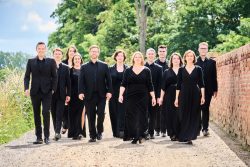 BATH Festival has always had music at its heart, with performances by many of the world’s leading soloists, ensembles and orchestras, including some of the finest interpreters of early music. This year’s festival, running to 26th May, saw the Bath debut of Stile Antico, a 12-strong a cappella ensemble dedicated to performing the vocal music of the Renaissance.
BATH Festival has always had music at its heart, with performances by many of the world’s leading soloists, ensembles and orchestras, including some of the finest interpreters of early music. This year’s festival, running to 26th May, saw the Bath debut of Stile Antico, a 12-strong a cappella ensemble dedicated to performing the vocal music of the Renaissance.
Celebrating their 20th anniversary next year, Stile Antico take their name from the 17th century term for the style of Renaissance church composition epitomised by the music of Palestrina. On their website, they describe it as “polyphonic and imitative in texture, even in rhythm, strictly controlled in its use of dissonance – as opposed to the modern developments in the works of Monteverdi and his contemporaries. Over the centuries, the ‘stile antico’ came to be seen as an ideal of musical purity.”
That musical purity was certainly on show in the beautiful setting of Bath Abbey, where the acoustic provided the perfect soundbox for the singers as they moved around, sometimes up by the altar or at the top of the nave and, for the Allegri Miserere, also at the west end.
The concert, titled The Golden Renaissance, featured sacred and secular works by Byrd, Taverner, Guerrero, Praetorius, Tallis, Tomkins, Gibbons, Sheppard and Victoria, all major figures of the period, from England, Spain and the Netherlands, whose music expresses the deepest human feelings. There was also an engaging performance of Shakespeare’s beautiful poem The Phoenix and The Turtle, set to music composed for Stile Antico by Huw Watkins.
The programme was made up of one work chosen from each of their 16 recordings, giving the audience an insight into the vocal, spiritual and emotional range of their repertoire – there was joy from Gibbons with his Hosanna to the Son of David and O Clap Your Hands, and Morales’ Jubilate Deo, contemplation from Byrd’s Retire My Soul, and profound melancholic beauty in Josquin’s Salve Regina.
For many in the audience, the best-known work was probably Allegri’s Miserere – a masterpiece with a fascinating history, based on its long concealment under a veil of secrecy, with performance allowed only in the Vatican. It was composed during the reign of Pope Urban VIII, probably during the 1630s, for the exclusive use of the Sistine Chapel during the Tenebrae services of Holy Week, and its mystique was increased by unwritten performance traditions and ornamentation. It is written for two choirs, of five and four voices respectively, singing alternately but joining together for the powerful finale.
Now one of the best-loved and most frequently performed of all Renaissance polyphonic choral works, it is particularly famous for the high Cs, and was sung here poignantly and exquisitely (there is no other word) by Stile Antico.
Bath Festival began in 1948 but the roots go back much further – Queen Elizabeth I is said to have come to Bath in 1568 to hear choirs sing at the abbey. It is not overly fanciful to imagine she may have heard some of the works sung at this year’s festival by Stile Antico. It is unarguable that this 21st century audience heard a performance that could not have been bettered – even during the composers’ lives.
FC
The concert was dedicated to the memory of Capt Brian Woodford.